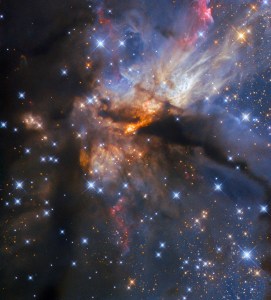
Hubble Spies Colorful Shroud of a Stellar Jet
This spectacular image from the NASA/ESA Hubble Space Telescope shows a region called G35.2-0.7N, which lies around 7,200 light-years from Earth in the constellation Aquila. G35.2-0.7N is known as a hotbed of high-mass star formation. The kind of stars that form here are so massive that they will end their lives as destructive supernovae. However, even as they form, they greatly influence their surroundings. At least one B-type star – the second most massive type – lurks within the region pictured here, and a powerful protostellar jet that is launching towards us is the source of the spectacular light show. Protostellar jets are enormous, collimated beams of matter ejected from very young stars called protostars. Collimated simply means that the matter is ejected in parallel (column-like) streams, which in turn means that the jets do not spread out much but extend out very far in relatively straight lines. This beautiful picture, taken with Hubble’s Wide Field Camera 3, was assembled using data collected primarily for very specific research purposes, as are most of Hubble’s images. The research conducted using these data included measuring the extent of ionization in the jets blasted out of the protostar buried within G35.2-0.7N. Ionization is a process by which atoms or molecules become charged, often because they are in such a high-energy environment that they have lost some of their electrons (the tiny negatively charged particles that orbit nuclei in atoms and molecules). The visual result of the ejected matter is the glorious display visible in this image. Much of the nebula is dark, with light being blocked from Hubble’s view by the rich dust clouds that produce these massive stars. Visible near the very center is the location of the star and the jet of material it is emitting. The small, bright orange streak is a cavity in the dust carved out by the ferocity of the jet as it streams towards us. By breaking through its dusty cocoon, the jet reveals light from the protostar, but there is still so much dust that the light is “reddened” to a fiery orange. The massive protostar lies at the very lower-left tip of this cavity.
- X

























